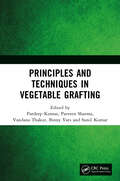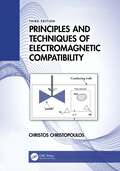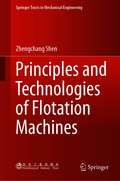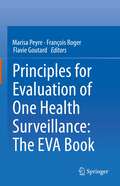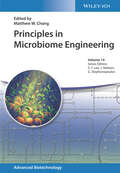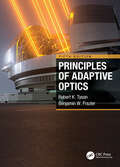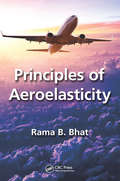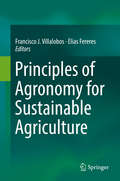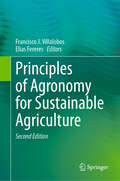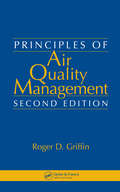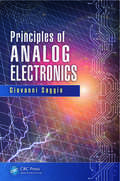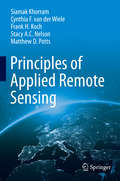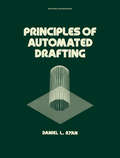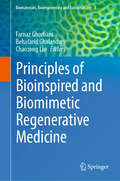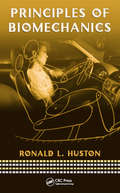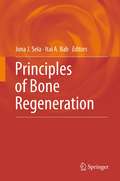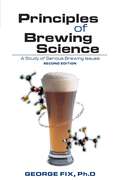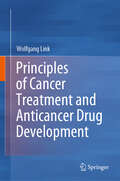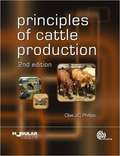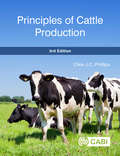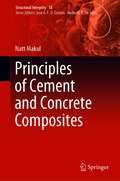- Table View
- List View
Principles and Techniques in Vegetable Grafting
by Sunil Kumar Pardeep Kumar Parveen Sharma Vandana Thakur Binny VatsWritten out of extensive research on vegetable grafting, this book contains current scientific and applied practical knowledge about its various aspects. A discussion of various practical issues pertinent to the field is carried out, and topics such as rootstocks and their significance, various methods of grafting, use of robotic machines, potential contribution of grafting and future perspectives of this technique towards improvement of vegetable production are also discussed.This book is aimed at aimed at both the people involved in the commercial production and cultivation of grafted plants as well as researchers interested in the understanding of the science and technology behind a grafted plant.Print edition not for sale in South Asia (India, Sri Lanka, Nepal, Bangladesh, Pakistan or Bhutan)
Principles and Techniques of Electromagnetic Compatibility (Electronic Engineering Systems)
by Christos ChristopoulosThis book provides a sound grasp of the fundamental concepts, applications, and practice of EMC. Developments in recent years have resulted in further increases in electrical component density, wider penetration of wireless technologies, and a significant increase in complexity of electrical and electronic equipment. New materials, which can be customized to meet EMC needs, have been introduced. Considerable progress has been made in developing numerical tools for complete system EMC simulation. EMC is now a central consideration in all industrial sectors. Maintaining the holistic approach of the previous edition of Principles and Techniques of Electromagnetic Compatibility, the Third Edition updates coverage of EMC to reflects recent important developments. What is new in the Third Edition? A comprehensive treatment of new materials (meta- and nano-) and their impact on EMC Numerical modelling of complex systems and complexity reduction methods Impact of wireless technologies and the Internet of Things (IoT) on EMC Testing in reverberation chambers, and in the time-domain A comprehensive treatment of the scope and development of stochastic models for EMC EMC issues encountered in automotive, railway, aerospace, and marine applications Impact of EMC and Intentional EMI (IEMI) on infrastructure, and risk assessment In addition to updating material, new references, examples, and appendices were added to offer further support to readers interested in exploring further. As in previous editions, the emphasis is on building a sound theoretical framework, and demonstrating how it can be turned to practical use in challenging applications. The expectation is that this approach will serve EMC engineers through the inevitable future technological shifts and developments.
Principles and Technologies of Flotation Machines (Springer Tracts in Mechanical Engineering)
by Zhengchang ShenThis book highlights the principles and technologies of flotation machine mainly used in mineral processing in detail. Froth flotation is one of the most important mineral processing techniques. Over 90% of the nonferrous minerals and 50% of the ferrous minerals in the world are treated using flotation: a complicated technique including procedures from chemistry, physics and multi-scale fluid mechanics. The book introduces readers to air-forced and air-induced flotation cells and discusses the various mechanical structures and working principles involved. A number of examples from industrial engineering practice are also discussed throughout the book, helping readers to better understand the technology and relevant equipment. The book is intended for researchers, professionals and graduate students in the fields of mining and mineral processing engineering.
Principles for Evaluation of One Health Surveillance: The EVA Book
by Marisa Peyre François Roger Flavie GoutardThis book outlines essential elements of the evaluation of health surveillance within the One Health concept. It provides an introduction to basic theoretical notions of evaluation and vividly discusses related challenges. Expert authors cover the entire spectrum of available, innovative methods, from those for system process evaluations to methods for the economic evaluation of the surveillance strategies. Each chapter provides a detailed description of the methodology required and the tools available as illustrated by practical examples of animal health or One Health surveillance evaluations in both developed and developing countries.Targeting not only scientists, including epidemiologists, but also technical advisers of decision-makers, the present work is suitable for the evaluation of any type of health surveillance system - animal, human or combined - regardless of the socio-economic context. The volume is richly equipped with practical tools and examples, which enables the reader to apply the methods described. Increasing importance of health surveillance, and threats from disease outbreaks such as the coronavirus pandemic, underline the practical relevance of this work, which will fill an important gap in the literature.
Principles in Microbiome Engineering (Advanced Biotechnology)
by Jens Nielsen Gregory Stephanopoulos Sang Yup LeePrinciples in Microbiome Engineering Provides an overview of the techniques and applications insight into the complex composition and interactions of microbiomes Microbiomes, the communities of microorganisms that inhabit specific ecosystems or organisms, can be engineered to modify the structure of microbiota and reestablish ecological balance. In recent years, a better understanding of microbial composition and host-microbe interactions has led to the development of new applications for improving human health and increasing agricultural productivity and quality. Principles in Microbiome Engineering introduces readers to the tools and applications involved in manipulating the composition of a microbial community to improve the function of an eco-system. Covering a range of key topics, this up-to-date volume discusses current research in areas such as microbiome-based therapeutics for human diseases, crop plant breeding, animal husbandry, soil engineering, food and beverage applications, and more. Divided into three sections, the text first describes the critical roles of systems biology, synthetic biology, computer modelling, and machine learning in microbiome engineering. Next, the volume explores various state-of-the-art applications, including cancer immunotherapy and prevention of diseases associated with the human microbiome, followed by a concluding section offering perspectives on the future of microbiome engineering and potential applications. Introduces a variety of applications of microbiome engineering in the fields of medicine, agriculture, and food and beverage products Presents current research into the complex interactions and relationships between microbiomes and biotic and abiotic elements of their environments Examines the use of technologies such as Artificial Intelligence (AI), Machine Learning (ML), and Big Data analytics to advance understanding of microbiomes Discusses the engineering of microbiomes to address human health conditions such as neuro psychiatric disorders and autoimmune and inflammatory diseases Edited and authored by leading researchers in the rapidly evolving field, Principles in Microbiome Engineering is an essential resource for biotechnologists, biochemists, microbiologists, pharmacologists, and practitioners working in the biotechnology and pharmaceutical industries.
Principles of Adaptive Optics
by Robert K. Tyson Benjamin West FrazierPrinciples of Adaptive Optics describes the foundations, principles, and applications of adaptive optics (AO) and its enabling technologies. This leading textbook addresses the fundamentals of AO at the core of astronomy, high-energy lasers, biomedical imaging, and optical communications. Key Features: Numerous examples to explain and support the underlying principles Hundreds of new references to support the topics that are addressed End-of-chapter questions and exercises A complete system design example threaded through each chapter as new material is introduced
Principles of Aeroelasticity
by Rama B. BhatIntroductory Guide on the Design of Aerospace Structures Developed from a course taught at Concordia University for more than 20 years, Principles of Aeroelasticity utilizes the author’s extensive teaching experience to immerse undergraduate and first-year graduate students into this very specialized subject. Ideal for coursework or self-study, this detailed examination introduces the concepts of aeroelasticity, describes how aircraft lift structures behave when subjected to aerodynamic loads, and finds its application in aerospace, civil, and mechanical engineering. The book begins with a discussion on static behavior, and moves on to static instability and divergence, dynamic behavior leading up to flutter, and fluid structure interaction problems. It covers classical approaches based on low-order aerodynamic models and provides a rationale for adopting certain aeroelastic models. The author describes the formulation of discrete models as well as continuous structural models. He also provides approximate methods for solving divergence, flutter, response and stability of structures, and addresses non-aeroelastic problems in other areas that are similar to aeroelastic problems. Topics covered include: The fundamentals of vibration theory Vibration of single degree of freedom and two degrees of freedom systems Elasticity in the form of an idealized spring element Repetitive motion Flutter phenomenon Classical methods, Rayleigh-Ritz techniques, Galerkin’s technique, influential coefficient methods, and finite element methods Unsteady aerodynamics, and more
Principles of Aeroelasticity (Dover Books on Engineering)
by Holt Ashley Raymond L. BisplinghoffPrinciples of Aeroelasticity constitutes an attempt to bring order to a group of problems which have coalesced into a distinct and mature subdivision of flight vehicle engineering. The authors have formulated a unifying philosophy of the field based on the equations of forced motion of the elastic flight vehicle. A distinction is made between static and dynamic phenomena, and beyond this the primary classification is by the number of independent space variables required to define the physical system.Following an introductory chapter on the field of aeroelasticity and its literature, the book continues in two major parts. Chapters 2 through 5 give general methods of constructing static and dynamic equations and deal specifically with the laws of mechanics for heated elastic solids, forms of aerodynamic operators, and structural operators. Chapters 6 through 10 survey the state of aeroelastic theory. The chapters proceed from simplified cases which have only a small, finite number of degrees of freedom, to one-dimensional systems (line structures), and finally to two-dimensional systems (plate- and shell-like structures).Chapter 9 combines some of the previous results by treating the unrestrained elastic vehicle in flight. All these chapters assume linear systems with properties independent of time, but Chapter 10 takes up the subject of systems which must be represented by nonlinear equations or by equations with time varying coefficients.
Principles of Agronomy for Sustainable Agriculture
by Francisco J. Villalobos Elias FereresThis textbook explains the various aspects of sustainable agricultures to undergraduate and graduate students. The book first quantifies the components of the crop energy balance, i. e. the partitioning of net radiation, and their effect on the thermal environment of the canopy. The soil water balance and the quantification of its main component (evapotranspiration) are studied to determine the availability of water to rain fed crops and to calculate crop water requirements. Then it sets the limitations of crop production in relation to crop phenology, radiation interception and resource availability (e. g. nutrients). With that in mind the different agricultural techniques (sowing, tillage, irrigation, fertilization, harvest, application of pesticides, etc. ) are analyzed with special emphasis in quantifying the inputs (sowing rates, fertilizer amounts, irrigation schedules, tillage plans) required for a given target yield under specific environmental conditions (soil & climate). For all techniques strategies are provided for improving the ratio productivity/resource use while ensuring sustainability. The book comes with online practical focusing on the key aspects of management in a crop rotation (collecting weather data, calculating productivity, sowing rates, irrigation programs, fertilizers rates etc).
Principles of Agronomy for Sustainable Agriculture
by Francisco J. Villalobos Elias FereresThis updated second edition textbook explains the different technologies of agronomy to achieve a more sustainable agriculture, for undergraduate and graduate students of agronomy. The first section gives an overview of the crop energy balance, which covers partitioning of net radiation, and their effect on the thermal environment of the canopy. Water balance, as one of the biggest concerns under a changing climate, will also be thoroughly discussed. For the second section, the authors prepare all relevant information on crop production in relation to crop phenology, radiation interception and resource availability. With that in mind, the different agricultural techniques are analyzed in the third section, with special emphasis on quantifying the inputs required for a given target yield under specific environmental conditions. For each technique, the chapters provide guidance on improving the ratio between productivity and resource use, while ensuring sustainability.
Principles of Air Conditioning (5th Edition)
by V. Paul LangThis proven text, now in its fifth edition, covers the fundamental principles of refrigeration and air conditioning. The material is intended to help learner develop practical skills required in all areas of A/C applications; design, installation, sales, & service. The technical information presented is fundamental to all types of domestic & commercial systems.
Principles of Air Quality Management
by Roger D. GriffinBlending information from popular mainstream articles, highly technical publications, and research journals, the second edition of Principles of Air Quality Management features new sections on air toxics, new information on chronic and acute health effects, and new approaches to the assessment of those impacts on sensitive populations. It em
Principles of Analog Electronics
by Giovanni SaggioRichly illustrated in full color, this textbook introduces you to the fascinating world of analog electronics, where fields, circuits, signals and systems, and semiconductors meet. The author expertly blends theory with practical examples to give a clear understanding of how real electronic circuits work. The book reviews the prerequisite mathematics, physics, and chemistry and the theory of circuits before delving into passive and active electronic devices. Taking a fresh approach, it connects electronics to everyday life through interesting observations, key personalities, and real-world applications.
Principles of Animal Nutrition
by Guoyao WuAnimals are biological transformers of dietary matter and energy to produce high-quality foods and wools for human consumption and use. Mammals, birds, fish, and shrimp require nutrients to survive, grow, develop, and reproduce. As an interesting, dynamic, and challenging discipline in biological sciences, animal nutrition spans an immense range from chemistry, biochemistry, anatomy and physiology to reproduction, immunology, pathology, and cell biology. Thus, nutrition is a foundational subject in livestock, poultry and fish production, as well as the rearing and health of companion animals. This book entitled Principles of Animal Nutrition consists of 13 chapters. Recent advances in biochemistry, physiology and anatomy provide the foundation to understand how nutrients are utilized by ruminants and non-ruminants. The text begins with an overview of the physiological and biochemical bases of animal nutrition, followed by a detailed description of chemical properties of carbohydrates, lipids, protein, and amino acids. It advances to the coverage of the digestion, absorption, transport, and metabolism of macronutrients, energy, vitamins, and minerals in animals. To integrate the basic knowledge of nutrition with practical animal feeding, the book continues with discussion on nutritional requirements of animals for maintenance and production, as well as the regulation of food intake by animals. Finally, the book closes with feed additives, including those used to enhance animal growth and survival, improve feed efficiency for protein production, and replace feed antibiotics. While the classical and modern concepts of animal nutrition are emphasized throughout the book, every effort has been made to include the most recent progress in this ever-expanding field, so that readers in various biological disciplines can integrate biochemistry and physiology with nutrition, health, and disease in mammals, birds, and other animal species (e.g., fish and shrimp). All chapters clearly provide the essential literature related to the principles of animal nutrition, which should be useful for academic researchers, practitioners, beginners, and government policy makers. This book is an excellent reference for professionals and a comprehensive textbook for senior undergraduate and graduate students in animal science, biochemistry, biomedicine, biology, food science, nutrition, veterinary medicine, and related fields.
Principles of Applied Remote Sensing
by Siamak Khorram Frank H. Koch Cynthia F. van der Wiele Stacy A. C. Nelson Matthew D. PottsThis textbook is one of the first to explain the fundamentals and applications of remote sensing at both undergraduate and graduate levels. Topics include definitions and a brief history of payloads and platforms, data acquisition and specifications, image processing techniques, data integration and spatial modeling, and a range of applications covering terrestrial, atmospheric, oceanographic and planetary disciplines. The policy and law issues of remote sensing and the future trends on the horizon are also covered. Remote sensing is an exciting, dynamic technology that is transforming the Earth sciences - terrestrial, atmospheric, and marine - as well as the practices of agriculture, disaster response, engineering, natural resources, providing evidence in legal cases and documented humanitarian crises, and many other fields. Increasingly, understanding of these techniques will be central to a number of disciplines, particularly as the technology advances.
Principles of Automated Drafting (Mechanical Engineering Ser. #28)
by Daniel L. RyanThis book introduces the reader to each phase of the subject, step-by-step to enable one to use the various automated drafting devices, instruments and technique of application. It shows the way to produce acceptable drafting in the framework of high productivity.
Principles of Bioinspired and Biomimetic Regenerative Medicine (Biomaterials, Bioengineering and Sustainability #3)
by Farnaz Ghorbani Behafarid Ghalandari Chaozong LiuNature has developed a diverse of materials, structures, and processes that are highly optimized for various functions. Through the field of biomimicry and bioinspiration, engineers are enhancing their understanding of natural design principles and applying these insights to create complex engineering models across different scales. These innovative approaches are particularly appropriate to address challenges in tissue engineering and regenerative medicine. Natural materials and systems exhibit a diverse array of functions, including but not limited to structural support, signal transduction, charge transfer, self-assembly, self-organization, and self-replication. Consequently, nature&’s "solution manual" is remarkably comprehensive. Despite significant advancements, the reconstruction of nature-inspired designs using synthetic materials presents ongoing challenges. As a result, nature and bioinspired materials and architectures have emerged as a paradigm shift within the realm of tissue engineering and regenerative medicine. This comprehensive guide aims to provide scientists with inspiration to address a variety of critical challenges in tissue regeneration by directly applying established design principles. A key focus of this volume is the utilization of bioinspired architectures in tissue engineering. It also emphasizes the development of nature-inspired structures through the integration of novel biological macromolecules, bioinspired polymers and hydrogels, as well as biomimetic ceramics. Furthermore, the text concentrates on the biochemical and biophysical dimensions of bioinspired surface engineering. Both dry-lab and wet-lab methodologies for characterizing nature and bio-inspired materials and structures are also addressed. The publication seeks to promote the development of high-level translational knowledge among both established and emerging scientists.
Principles of Biomechanics
by Ronald HustonResearch and study in biomechanics has grown dramatically in recent years, to the extent that students, researchers, and practitioners in biomechanics now outnumber those working in the underlying discipline of mechanics itself. Filling a void in the current literature on this specialized niche, Principles of Biomechanics provides readers with a so
Principles of Bone Regeneration
by Jona J. Sela Itai A. BabPrinciples of Bone Regeneration is a timely publication that addresses the modern aspects of bone healing and repair. This exciting new volume details the convergence of the different experimental and clinical approaches designed for the study and treatment of bone healing in its diverse forms and under varying conditions. Bone healing is affected by a multitude of genetic, environmental, mechanical, cellular and endocrine variables which eventually lead to changes in gene expression that enhance the guided action of osteoblasts (and chondroblasts) to lay down bone that restores, or even improves, the skeletal load bearing capacity. Recent breakthroughs in understanding the regulatory aspects of bone formation and resorption, in both research and clinical arenas offer new modalities to induce, enhances and guide repair processes in bone for the benefit of millions of patients with conditions such as nonunion fractures, critical size defects, orthodontic tooth movement, periodontal bone loss, intraosseous implants and deformed bones.
Principles of Brewing Science: A Study of Serious Brewing Issues
by George FixPrinciples of Brewing Science is an indispensable reference which applies the practical language of science to the art of brewing. As an introduction to the science of brewing chemistry for the homebrewer to the serious brewer&’s desire for detailed scientific explanations of the process, Principles is a standard addition to any brewing bookshelf.
Principles of Cancer Treatment and Anticancer Drug Development
by Wolfgang LinkThis book explains how current medicines against cancer work and how we find new ones. It provides an easy-to-understand overview of current options to treat patients with cancer, which includes Surgery, Radiation therapy, Chemotherapy, Targeted therapy and Immunotherapy. The efficiency of all these treatments is limited by the capacity of cancer cells to escape therapy. This book explains the mechanisms of anti-cancer drug resistance and strategies to overcome it. The discovery and development process of a new drug is detailed beginning with the identification and validation of a therapeutic target, the identification of an inhibitor of the target and its subsequent preclinical and clinical development until its approval by regulatory authorities. Particular emphasis has been given to specific aspects of the development process including lead generation and optimization, pharmacokinetics, ADME analysis, pharmacodynamics, toxicity and efficacy assessment, investigational new drug (IND) and new drug application (NDA) and the design of clinical trial and their phases. The book covers many aspects of modern personalized oncology and discusses economic aspects of our current system of developing new medicines and its impact on our societies and on future drug research. The author of this book, Dr. Link counts with more than 20 years of experience in biomedical research reflected in numerous publications, patents and key note and plenary presentations at international conferences. Interested readers, students and teachers should read this book as it provides a unique way to learn/teach about basic concepts in oncology and anti-cancer drug research.
Principles of Cattle Production
by Clive PhillipsThis introductory level textbook covers the welfare and environmental implications of producing cattle as well as traditional subjects such as nutrition, reproduction and housing. Its broad, international coverage includes feedlot systems, transport, subsistence farming systems and the contribution of cattle production systems to land, air and water pollution. It is an invaluable resource for undergraduate students of animal science, veterinary medicine and agriculture, as well as diploma and certificate courses and industry personnel.
Principles of Cattle Production
by Clive PhillipsCompletely updated and revised, the new edition of Principles of Cattle Production continues to provide an introductory level text for all interested in dairy and beef cattle production systems. This edition presents a vision for a cattle industry that addresses issues about impacts on the environment, the welfare of cattle and the provision of safe and high quality food for an increasingly demanding world population. The new edition: - Is expanded to include more on animal welfare, sustainability and production systems in low and middle income countries, including smallholder production systems. - Has undergone a thorough review of all the existing chapters, with new content on the future role of cattle. - Contains quality colour illustrations, so that key information can be found at a glance. - Is beautifully written with many examples and pointers for further information. - Tackles key issues of sustainability and the requirement for increased production. - Now contains helpful exercises and other resources for students and their teachers to consider the role of cattle in the world today and in the future. Principles of Cattle Production 3rd Edition continues to provide a comprehensive yet concise overview for all undergraduate students of animal science, agriculture, veterinary medicine, animal welfare and industry personnel.
Principles of Cattle Production
by Clive PhillipsCompletely updated and revised, the new edition of Principles of Cattle Production continues to provide an introductory level text for all interested in beef and dairy cattle production systems. This edition presents a vision for a cattle industry that addresses the environment, the welfare of cattle and the provision of safe and high quality food for an increasingly demanding world population. The new edition: - Is expanded to include more on animal welfare, sustainability and production systems in low and middle income countries, including smallholder production systems. - Has undergone a thorough review of all the existing chapters with new content on breeding cattle and the future role of cattle. - Contains quality colour illustrations, so that key information can be found at a glance. - Is beautifully written with many examples and pointers for further information. - Tackles key issues of sustainability and the requirement for increased production. Principles of Cattle Production 3rd Edition continues to provide a comprehensive yet concise overview for all undergraduate students of animal science, agriculture, veterinary medicine, animal welfare and industry personnel.
Principles of Cement and Concrete Composites (Structural Integrity #18)
by Natt MakulThis book presents an introduction, a discussion of the concept of the design and the concrete’s development, and the properties and testing of the concrete in fresh and hardened stages. After an introduction to the principles of cement and concrete composites, the reader will find information on the principles of quantum-scaled cement, low-carbon cement, fiber-reinforced concrete, reactive powder concrete, and tailor-made recycled aggregate concrete.
